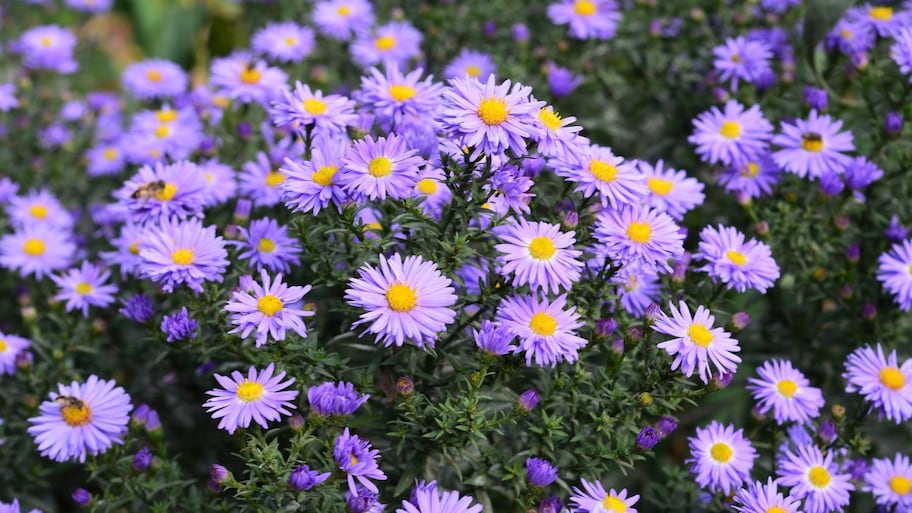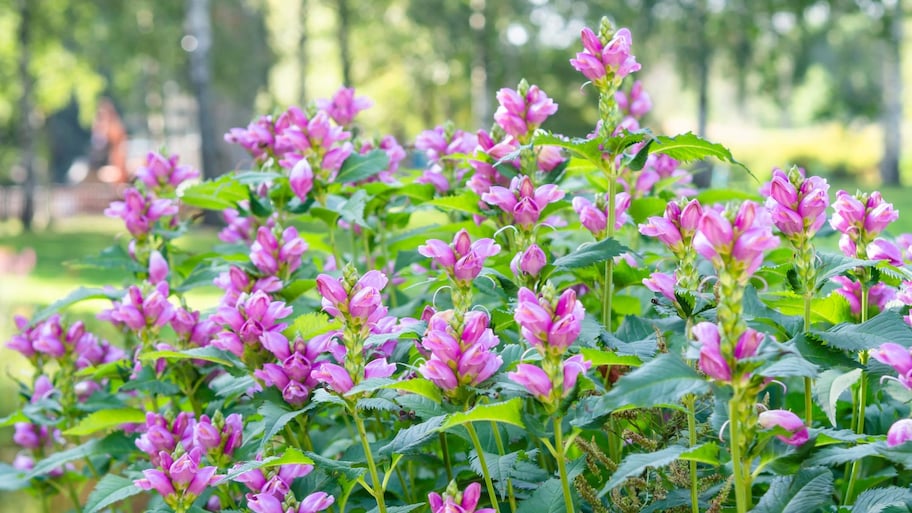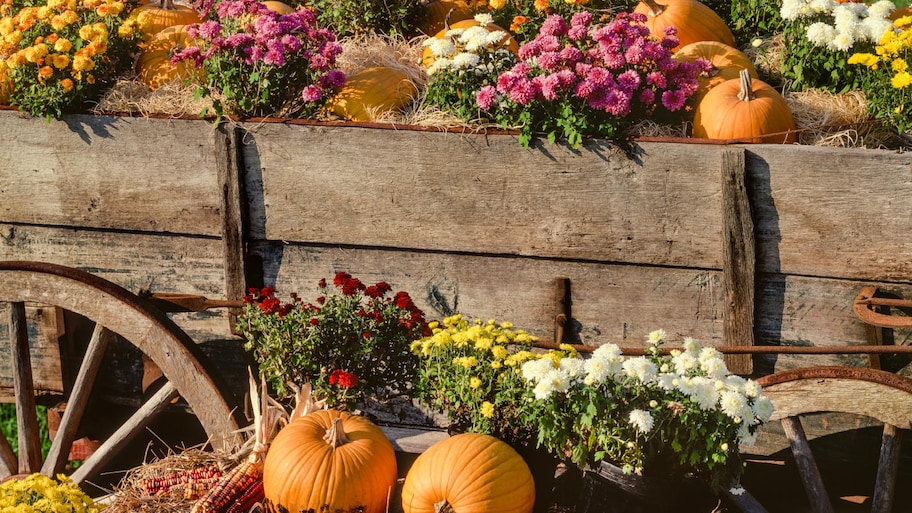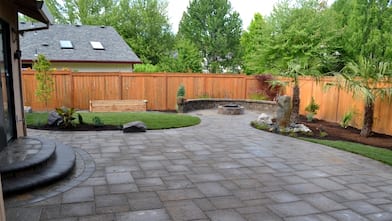Say goodbye to the summer heat with a stunning fall garden
As the weather shifts from scorching hot to cool and crisp, your garden might need a makeover. When you think of fall, you may focus on the changing leaves and everything pumpkin, but you can (and should!) also take advantage of the cooler, rainier weather by adding some fall flowers to your garden.
To help get you started, we’ll share some of the best fall flowers to plant that can totally change the look of your porch or flower beds. After all, what better backdrop for your jack-o-lantern photos than some gorgeous red and orange blooms?
1. Chrysanthemum

Chrysanthemums—or mums, for short—are iconic fall flowers. These dazzling blooms come in all shades of the rainbow, with red, orange, and yellow mums especially bringing out the fall season. They require even moisture to thrive, which is why it’s a good idea to hold off on planting until fall in climates prone to droughts.
Use chrysanthemums directly in your garden as a border plant for a profound effect or place a couple of pots on your porch to bring in the changing seasons with a splash of color.
2. Aster

Asters are a popular, late-blooming choice for spring and fall that resemble dainty purple or white daisies. This drought-resistant plant sports a beautiful, bright yellow pistil in the center, which attracts pollinators like butterflies.
Choose a native aster plant. If you purchase any old aster, you might choose one that isn’t suited to your climate. Some asters do best in cool areas where they can receive light rainfall and direct sunlight, while other aster plants are drought-resistant and can do well in partial sunlight if you live in a warmer climate.
If you’re unsure which asters are right for your climate, or where in your garden they’ll thrive best, a local gardener can be a great resource.
3. Chelone (Turtlehead)

Turtlehead, also known as chelone, is a native perennial plant that, as the name suggests, blooms pink, red, or white flowers that resemble a turtle’s head. Turtlehead plants grow up to 3 feet tall in thick clumps and attract hummingbirds and other pollinators. These plants stay a dark green for most of the year and then come to life in the fall with other perennial plants in your garden.
The plant grows best in moist climates, so you’re likely to find turtleheads growing in swamps or near bodies of water—but that doesn’t mean you can’t grow them in your yard. If you have a pond or live in a humid climate, turtlehead is an excellent choice for your garden.
4. Coneflower

Coneflowers are perennial plants that come from the daisy family. These plants, which are native to the Eastern and Central U.S., blossom in shades of purple or yellow and can reach up to 4 feet tall. They’ll flower from midsummer until the frost, and their cone-like shape gives them their name and also attracts bees, butterflies, and birds.
If you’ve already decided to plant chrysanthemums, planting coneflowers is akin to nurturing two peas in a pod. These plants grow well together, and you can even pair them side-by-side in a planter box for a subtle pop of purple among the autumny-looking mums.
5. Black-Eyed Susan

While these flowers resemble a merge between sunflowers and daisies, black-eyed Susans are native plants that grow throughout North America. Their golden hue, dark brown center and offer a stunning pop of autumnal color to your garden. Plus, they are amenable to different types of spaces, as they come in a wide range of heights, with some as short as 12 inches and some as tall as 3 feet.
You can plant black-eyed Susans along your garden's borders or in planter containers. Just keep in mind that this plant can compete with other flowers in your garden and may do best in a contained space.
6. Hydrangea

For a garden bursting with color and sophistication, the hydrangea takes the cake. These flowering plants have an old-fashioned look that goes well with historic or cottage-chic homes. They bloom in all kinds of colors—from blue, pink, purple, and more—and can grow up to 15 feet in height!
Hydrangeas do well in garden beds, as shrub borders, or in containers. Keep them out of direct sunlight, away from trees, and in soil with good drainage for the most vibrant flowers. If you’re unsure of your soil type, you might want to ask a local landscaping company for advice.
7. Autumn Crocus

Autumn crocus is part of the lily family and originates from Europe and North Africa. The plant tends to blossom in pink, purple, and white and it thrives in damp meadows and woods and blooms in early fall. Initially, the plant resembles a green tulip, but come fall, the flowers grow and last for approximately two weeks.
This bloom thrives under leafy trees, tall shrubs, or other tall perennial plants, but be sure to give autumn crocus full sunlight for the best environment. This hardy plant can grow in gravel gardens, making it ideal for arid climates with rocky terrains.
8. Goldenrod

Goldenrod plants emerge towards the end of summer, offering tall, feathery flowers that will turn any garden into a whimsical fairytale. These native prairie plants can grow up to 6 feet tall and are part of the aster family, despite looking far different from other asters. The plant is deer-resistant and drought-resistant and thrives in all kinds of soils.
Goldenrod is easy to grow—so easy, in fact, some people even consider them weeds. For this reason, you might want to plant them around the borders of your garden. With over 100 species suited to all kinds of climates, make sure that the goldenrod plant you choose for your garden thrives in your environment.
9. Helenium

Helenium is another plant that simply screams late summer and early autumn. From the red, yellow, and orange hues to the often dark brown pistil, this plant can grow up to 5 feet tall. Helenium plants require full sun exposure and are native to North America.
For this plant species to thrive, it needs plenty of sunlight—at least six hours per day. These flowers also need lots of moisture, making them ideal for climates that receive ample rainfall.
10. Russian Sage

For a low-maintenance landscape, Russian sage offers a gorgeous lavender-colored flower with little work from you. The plant starts out with green foliage and then blooms in midsummer to dazzle all who walk by to admire your garden. You won’t have to worry about deer eating this plant, either: Like most plants from the sage family, Russian sage is a naturally deer-resistant plant.
Russian sage is excellent for arid climates that receive very little rain. It can grow up to 4 feet tall, needs full sunlight, and can either grow in containers or in open spaces.
11. Sedum

Sedum plants are a perennial favorite, sporting beautiful green foliage and flowers resembling clusters of stars. Sedums come in a myriad of varieties, most notably in shades of mauve, yellow, or pink. Pollinators also love sedum plants, and they are easy to grow.
You’ll want to avoid planting sedum flowers in clay soil, as this plant needs well-drained soil to thrive. Choose a low-growing sedum or a taller, upright sedum plant for added layers and dimension in your garden.

 - Allie Ogletree.jpeg?impolicy=thumbnail)



